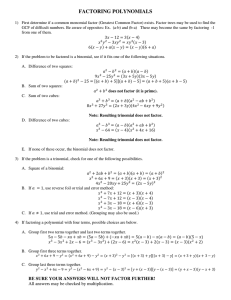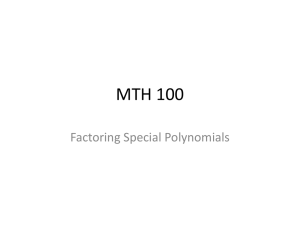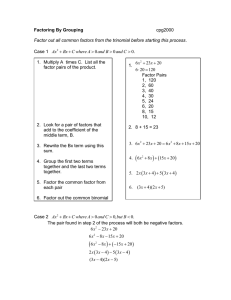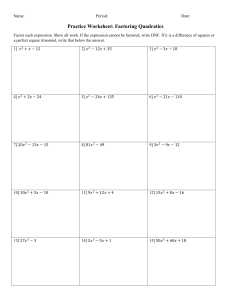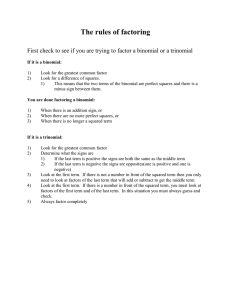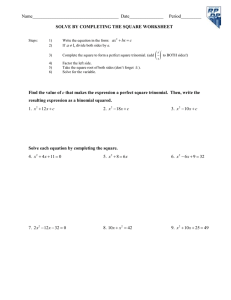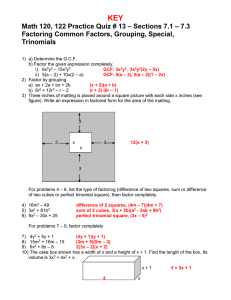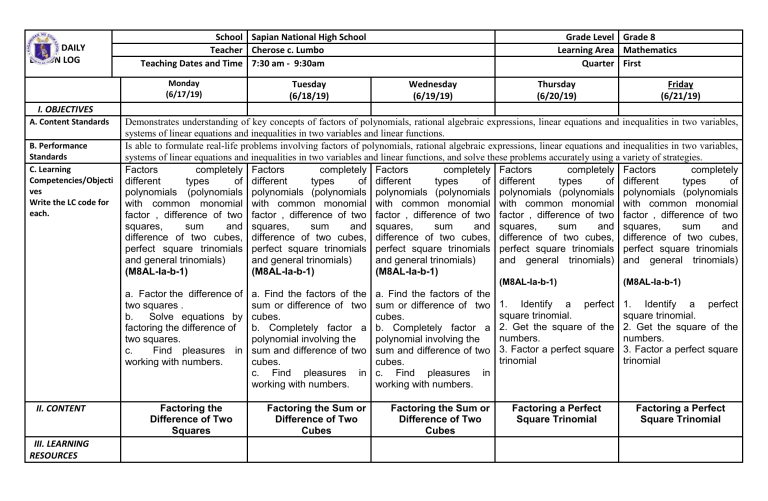
DAILY
LESSON LOG
School Sapian National High School
Teacher Cherose c. Lumbo
Teaching Dates and Time 7:30 am - 9:30am
Monday
(6/17/19)
Tuesday
(6/18/19)
Grade Level Grade 8
Learning Area Mathematics
Quarter First
Wednesday
(6/19/19)
Thursday
(6/20/19)
Friday
(6/21/19)
I. OBJECTIVES
A. Content Standards
B. Performance
Standards
C. Learning
Competencies/Objecti
ves
Write the LC code for
each.
Demonstrates understanding of key concepts of factors of polynomials, rational algebraic expressions, linear equations and inequalities in two variables,
systems of linear equations and inequalities in two variables and linear functions.
Is able to formulate real-life problems involving factors of polynomials, rational algebraic expressions, linear equations and inequalities in two variables,
systems of linear equations and inequalities in two variables and linear functions, and solve these problems accurately using a variety of strategies.
Factors
completely Factors
completely Factors
completely Factors
completely Factors
completely
different
types
of different
types
of different
types
of different
types
of different
types
of
polynomials (polynomials polynomials (polynomials polynomials (polynomials polynomials (polynomials polynomials (polynomials
with common monomial with common monomial with common monomial with common monomial with common monomial
factor , difference of two factor , difference of two factor , difference of two factor , difference of two factor , difference of two
squares,
sum
and squares,
sum
and squares,
sum
and squares,
sum
and squares,
sum
and
difference of two cubes, difference of two cubes, difference of two cubes, difference of two cubes, difference of two cubes,
perfect square trinomials perfect square trinomials perfect square trinomials perfect square trinomials perfect square trinomials
and general trinomials)
and general trinomials)
and general trinomials)
and general trinomials) and general trinomials)
(M8AL-Ia-b-1)
(M8AL-Ia-b-1)
(M8AL-Ia-b-1)
a. Factor the difference of
two squares .
b.
Solve equations by
factoring the difference of
two squares.
c.
Find pleasures in
working with numbers.
II. CONTENT
III. LEARNING
RESOURCES
Factoring the
Difference of Two
Squares
a. Find the factors of the
sum or difference of two
cubes.
b. Completely factor a
polynomial involving the
sum and difference of two
cubes.
c. Find pleasures in
working with numbers.
a. Find the factors of the
sum or difference of two
cubes.
b. Completely factor a
polynomial involving the
sum and difference of two
cubes.
c. Find pleasures in
working with numbers.
Factoring the Sum or
Difference of Two
Cubes
Factoring the Sum or
Difference of Two
Cubes
(M8AL-Ia-b-1)
(M8AL-Ia-b-1)
1. Identify a perfect
square trinomial.
2. Get the square of the
numbers.
3. Factor a perfect square
trinomial
1. Identify a perfect
square trinomial.
2. Get the square of the
numbers.
3. Factor a perfect square
trinomial
Factoring a Perfect
Square Trinomial
Factoring a Perfect
Square Trinomial
A. References
pages 34-35
pages 36-37
pages 36-37
pages 38-39
pages 38-39
1. Teacher’s
Guide pages
pages 32-33
pages 34-35
pages 34-35
pages 36-38
pages 36-38
2. Learner’s
Materials pages
3. Textbook
Mathematics Activity Mathematics Activity Mathematics Activity Intermediate Algebra Intermediate Algebra
pages Sourcebook
pages UBD pages 24-25
UBD pages 24-25
pages
Sourcebook pages 22- Sourcebook
25- 26
25- 26
23
4. Additional
Materials from
Learning
Resource
(LR) portal
B. Other Learning
Resources
IV. PROCEDURES
http://lmrds.deped.gov. http://lmrds.deped.gov http://lmrds.deped.gov http://lmrds.deped.gov http://lmrds.deped.gov
ph.
.ph.
.ph.
.ph.
.ph.
Grade 8 LCTG
by
Dep
Ed
Cavite
Mathematics 2016
laptop, LCD
Grade 8 LCTG by
Dep
Ed
Cavite
Mathematics 2016
laptop, LCD
Grade 8 LCTG by
Dep
Ed
Cavite
Mathematics 2016
laptop, LCD
Grade 8 LCTG by
Dep
Ed
Cavite
Mathematics 2016
laptop, LCD
Grade 8 LCTG by
Dep
Ed
Cavite
Mathematics 2016
laptop, LCD
A. Reviewing previous
lesson or presenting
the new lesson.
SECRET MESSAGE
Find the square roots and solve the
secret message.
4 = ___ 16 = ___
16 = ___ 81 = ___
49 = ___
9 = ___
81 = ___ 25 = ___
16 = ___ 100 = ___
9 = ___ 36 = ___
121= ___ 16 = ___
25 = ___
9 = ___
144 = ___ 64 = ___
81= ___ 289 = ___
225 = ___ 49 =___
9 = ___ 81 = ___
25= ___ 16 =___
100 = ___ 9 =___
A
16
B
16
C
25
D
1000
E
299
F
100
G
400
H
4
I
36
J
81
K
64
L
81
M
144
N
100
O
9
P
64
Q
49
R
900
S
121
T
4
U
24
V
9
W
81
X
225
Y
8
B. Establishing a
purpose for the lesson.
X
9
Factoring the difference of two
squares is the reverse process
of the product of sum and
difference of two terms.
(x + y)(x – y) = x2 – y2
Purpose Setting Activity
So here are the formulas that
summarize how to factor the sum
and difference of two cubes.
Study them carefully using the
following diagrams.
Purpose Setting Activity
So here are the formulas that
summarize how to factor the sum
and difference of two cubes.
Study them carefully using the
following diagrams.
Observations:
•For the “sum” case, the binomial
factor on the right side of the
equation has a middle sign that is
positive.
•In addition to the “sum” case, the
middle sign of the trinomial factor
will always be opposite the middle
sign of the given problem.
Therefore, it is negative.
•For the “difference” case, the
binomial factor on the right side of
the equation has a middle sign that
is negative.
•In addition to the “difference”
case, the middle sign of the
trinomial factor will always be
opposite the middle sign of the
given problem. Therefore, it is
positive.
Factoring the sum or difference of
two cubes is the reverse process
of product of binomial and
trinomial.
(x + y)(x2 – xy + y2)
= x3 + y 3
(x + y)(x2 + xy + y2)
Observations:
•For the “sum” case, the binomial
factor on the right side of the
equation has a middle sign that is
positive.
•In addition to the “sum” case, the
middle sign of the trinomial factor
will always be opposite the middle
sign of the given problem.
Therefore, it is negative.
•For the “difference” case, the
binomial factor on the right side of
the equation has a middle sign that
is negative.
•In addition to the “difference”
case, the middle sign of the
trinomial factor will always be
opposite the middle sign of the
given problem. Therefore, it is
positive.
Factoring the sum or difference of
two cubes is the reverse process
of product of binomial and
trinomial.
(x + y)(x2 – xy + y2)
= x3 + y 3
(x + y)(x2 + xy + y2)
Find the square of the following:
Find the square of the following:
1. 1
2. 4
3. 9
4. 16
5. 25
1. 1
2. 4
3. 9
4. 16
5. 25
6. 36
7. 49
8. 81
9. a2
10. x4
Factoring a perfect square
trinomial is the reverse process
of square o binomial.
(x + y)2 = x2 + 2xy + y2
(x - y)2 = x2 - 2xy + y2
6. 36
7. 49
8. 81
9. a2
10. x4
Factoring a perfect square
trinomial is the reverse process
of square o binomial.
(x + y)2 = x2 + 2xy + y2
(x - y)2 = x2 - 2xy + y2
= x3 - y3
C. Presenting
examples/instances of
the new lesson.
2
6
Factor 4y - 36y
•There is a common factor of 4y2 that
can be factored out first in this problem,
to make the problem easier.
4y2 (1 - 9y4)
•In the factor (1 - 9y4), 1 and 9y4 are
perfect squares (their coefficients are
perfect squares and their exponents are
even numbers). Since subtraction is
occurring between these squares, this
expression is the difference of two
squares.
•What times itself will give 1?
•What times itself will give 9y4 ?
•The factors are (1 + 3y2) and (1 - 3y2).
•Answer:
4y2 (1 + 3y2)(1 - 3y2) or
4y2 (1 - 3y2) (1 + 3y2)
= x3 - y3
3
1: Factor x + 27
Currently the problem is not
written in the form that we want. Each
term must be written as cube, that is,
an expression raised to a power of 3.
The term with variable x is okay but the
27 should be taken care of. Obviously
we know that 27 = (3)(3)(3) = 33.
Rewrite the original problem as
sum of two cubes, and then simplify.
Since this is the "sum" case, the
binomial factor and trinomial factor will
have positive and negative middle
signs, respectively.
x3 + 27 = (x)3 + (3)3
= (x+3)[{x)2 –(x)(3)+(3)2]
=(x+3)(x2-3x+9)
1: Factor x3 + 27
Currently the problem is not
written in the form that we want. Each
term must be written as cube, that is,
an expression raised to a power of 3.
The term with variable x is okay but the
27 should be taken care of. Obviously
we know that 27 = (3)(3)(3) = 33.
Rewrite the original problem as
sum of two cubes, and then simplify.
Since this is the "sum" case, the
binomial factor and trinomial factor will
have positive and negative middle
signs, respectively.
x3 + 27 = (x)3 + (3)3
= (x+3)[{x)2 –(x)(3)+(3)2]
=(x+3)(x2-3x+9)
Example 2: Factor y3 - 8
This is a case of difference of
two cubes since the number 8 can be
written as a cube of a number, where 8
= (2)(2)(2) = 23.
Apply the rule for difference of
two cubes, and simplify. Since this is
the "difference" case, the binomial
factor and trinomial factor will have
negative and positive middle signs,
respectively.
Example 2: Factor y3 - 8
This is a case of difference of
two cubes since the number 8 can be
written as a cube of a number, where 8
= (2)(2)(2) = 23.
Apply the rule for difference of
two cubes, and simplify. Since this is
the "difference" case, the binomial
factor and trinomial factor will have
negative and positive middle signs,
respectively.
D. Discussing new
concepts and
practicing new skills
#1.
Factor each of the following:
1. c² - d²
2. 1 - a²
3. ( a + b )² - 4c²
4. 16x² - 4
5. a²b² - 144
Factor the following:
1. x3 – 8
2. 27x3 + 1
3. x3y6 – 64
4. m³ + 125
5. x³ + 343
Factor the following:
1. x3 – 8
2. 27x3 + 1
3. x3y6 – 64
4. m³ + 125
5. x³ + 343
E. Discussing new
concepts and
practicing new skills
#2.
Fill in the blanks to make the sides
of each equation equivalent.
1. ( _____ ) ( x – 9)
= x² -81
2. ( 20 + 4) ( _____ )
= 20² -4²
3. ( _____ ) (2a +3 )
= 4a² - 9
4. ( 6x²y + 3ab)(6x²y -3ab)
=(
_____ ) - 9a²b²
5. ( 13 + x ) (13 – x)
= _____ - x²
Complete the factoring.
1. t3 - w3
=(t–w)(
2. m3 + n3
=(m+n)(
3. x3 + 8
= (x+2)(
4. y3 - 27
=(y–3)(
5. 8- v3
=(2–v)(
Complete the factoring.
1. t3 - w3
=(t–w)(
2. m3 + n3
=(m+n)(
3. x3 + 8
= (x+2)(
4. y3 - 27
=(y–3)(
5. 8- v3
=(2–v)(
)
)
)
)
)
Study the trinomials and
corresponding binomial factors.
1. x2 + 10x + 25 = ( x + 5)2
2. 49x2 – 42 + 9
= ( 7x – 3)2
3. 36 + 20 m + 16m2
= (6 + 4m)2
4. 64x2 – 32xy + 4y2
= (8x – 2y)2
their
Study the trinomials and
corresponding binomial factors.
1. x2 + 10x + 25 = ( x + 5)2
2. 49x2 – 42 + 9
= ( 7x – 3)2
3. 36 + 20 m + 16m2
= (6 + 4m)2
4. 64x2 – 32xy + 4y2
= (8x – 2y)2
a. Relate the first term in the trinomial
to the first term in the binomial
factors.
b. Compare the second term in the
trinomial factor and the sum of the
product of the inner terms and
outer terms of the binomials.
c. Observe the third term in the
trinomial and the product of the
second terms in the binomials.
a. Relate the first term in the trinomial
to the first term in the binomial
factors.
b. Compare the second term in the
trinomial factor and the sum of the
product of the inner terms and
outer terms of the binomials.
c. Observe the third term in the
trinomial and the product of the
second terms in the binomials.
Supply the missing term to make a
true statement.
1. m2 + 12m + 36
= (m + ___)2
2. 16d2 – 24d + 9
= (4d – ___)2
3. a4b2 – 6abc + 9c2
= (a2b ___)2
4. 9n2 + 30nd + 25d2
= (____ 5d)2
5. 49g2 – 84g +36
= ( ______)2
Factor the following trinomials.
1. x2 + 4x + 4
Supply the missing term to make a
true statement.
1. m2 + 12m + 36
= (m + ___)2
2. 16d2 – 24d + 9
= (4d – ___)2
3. a4b2 – 6abc + 9c2
= (a2b ___)2
4. 9n2 + 30nd + 25d2
= (____ 5d)2
5. 49g2 – 84g +36
= ( ______)2
Factor the following trinomials.
1. x2 + 4x + 4
2. x2 - 18x + 81
3. 4a2 + 4a + 1
4. 25m2 – 30m + 9
5. 9p2 – 56p + 16
2. x2 - 18x + 81
3. 4a2 + 4a + 1
4. 25m2 – 30m + 9
5. 9p2 – 56p + 16
)
)
)
)
)
their
Factor each completely.
a) x ³ + 125
b) a ³ + 64
c) x ³ – 64
d) u ³ + 8
Factor each completely.
a) x ³ + 125
b) a ³ + 64
c) x ³ – 64
d) u ³ + 8
G. Finding practical
applications of
concepts and skills in
daily living.
Factorize the following by taking the
difference of squares:
1. x2 – 100
2. a2 – 4
3. ab2 – 25
4. 36𝑥2 – 81
5. 54𝑥2 – 6y2
Factor the following.
1. 100a2 – 25b2
2. 1 – 9a2
3. 81x2 – 1
4. – 64a2 + 169 b2
5. x2 – 144
Directions. Find the cube roots. Then,
match each solution to the numbers at
the bottom of the page. Write the
corresponding letter in each blank to
the question.In the survey, Best place
for family picnic in Roxas City?
Directions. Find the cube roots. Then,
match each solution to the numbers at
the bottom of the page. Write the
corresponding letter in each blank to
the question.In the survey, Best place
for family picnic in Roxas City?
H. Making
generalizations and
abstractions about the
lesson.
The factors of the difference of two
squares are the sum of the square roots
of the first and second terms times the
difference of their square roots.
*The factors of 𝑎2 − 𝑏2
=𝑎𝑟𝑒 ( 𝑎 + 𝑏 ) 𝑎𝑛𝑑 ( 𝑎 −𝑏 ).
1. The sum of the cubes of two terms is
equal to the sum of the two
terms multiplied by the sum of
the squares of these terms minus
the product of these two terms.
a³ + b³
= ( a + b ( a² - ab + b² )
1. The sum of the cubes of two terms is
equal to the sum of the two
terms multiplied by the sum of
the squares of these terms minus
the product of these two terms.
a³ + b³
= ( a + b ( a² - ab + b² )
2. The difference of the cubes of two
terms is equal to the difference of
the two terms multiplied by the sum
of the squares of these two terms
plus the product of these two
terms.
a³ - b³
= ( a - b ( a² + ab + b² )
Supply the missing expression.
1. 𝑚3 - 27
= (m – 3) _________
2. 64 + 27𝑛3
= ____(16 – 12n + 9𝑛2 )
3. _______
= ( 2p + 5q ) ( 4𝑝2 – 10pq + 25𝑞2 )
4. 𝑥6 + 1000
= _____𝑥4 - 10𝑥2 + 100 )
2. The difference of the cubes of two
terms is equal to the difference of
the two terms multiplied by the sum
of the squares of these two terms
plus the product of these two
terms.
a³ - b³
= ( a - b ( a² + ab + b² )
Supply the missing expression.
5.
1. 𝑚3 - 27
6.
= (m – 3) _________
2. 64 + 27𝑛3
= ____(16 – 12n + 9𝑛2 )
3. _______
= ( 2p + 5q ) ( 4𝑝2 – 10pq + 25𝑞2 )
4. 𝑥6 + 1000
= _____𝑥4 - 10𝑥2 + 100 )
5. ________
= ( 6x – 7y ) ( 36𝑥2 + 42xy + 49𝑦2 )
Solve the following:
5. ________
= ( 6x – 7y ) ( 36𝑥2 + 42xy + 49𝑦2 )
Solve the following:
1. The product of two consecutive even
integers is 528. Find the value of
each integer.
1. The product of two consecutive even
integers is 528. Find the value of
each integer.
F. Developing mastery
(Leads to Formative
Assessment #3).
I. Evaluating learning.
J. Additional activities
for application or
remediation.
V. REMARKS
Factorize the following by taking the
difference of squares:
1. x2 – 9
2. a2 – 1
3. ab2 – 16
4. 16𝑥2 – 49
5. 54𝑥2 – 6y2
Factorize the following by taking the
difference of squares:
1.
2.
3.
4.
5.
x2 – 9
a2 – 1
ab2 – 16
16𝑥2 – 49
54𝑥2 – 6y2
1.
2.
Factor the following:
1. x2 – 5x + 25
2. b2 -10b + 100
3. 36b2 – 12b + 1
4. 49p2 – 56p = 16
5. 49k2 – 28kp + 4p2
3.
4.
Factor the following:
1. x2 – 5x + 25
2. b2 -10b + 100
3. 36b2 – 12b + 1
4. 49p2 – 56p = 16
5. 49k2 – 28kp + 4p2
Complete the perfect square trinomial
and factor them.
1. ___ + 16x + 64
2. x2 - ___ + 49
3. x2 + 4x + ___
4. x2 + ___ + 9y2
5. ___ + 10k + 25
In factoring a perfect square trinomial,
the following should be noted:
1. The factors are binomials with like
terms
wherein the terms are the square
roots of the first and the last terms
of the trinomial.
2. The sign connecting the
terms of the binomial
factors is the same as
the sign of the middle
term of the trinomial.
Complete the perfect square trinomial
and factor them.
1. ___ + 16x + 64
2. x2 - ___ + 49
3. x2 + 4x + ___
4. x2 + ___ + 9y2
5. ___ + 10k + 25
In factoring a perfect square trinomial,
the following should be noted:
1. The factors are binomials with like
terms
wherein the terms are the square
roots of the first and the last terms
of the trinomial.
2. The sign connecting the
terms of the binomial
factors is the same as
the sign of the middle
term of the trinomial.
Factor the following:
1. x2 – 6x + 9
2. b2 -12b + 36
3. 4b2 – 4b + 1
4. 49p2 – 56p = 16
5. 49k2 – 28kp + 4p2
Factor the following:
1. x2 – 6x + 9
2. b2 -12b + 36
3. 4b2 – 4b + 1
4. 49p2 – 56p = 16
5. 49k2 – 28kp + 4p2
7.
8.
Complete the perfect square trinomial
and factor them.
Complete the perfect square trinomial
and factor them.
1. ___ + 16x + 64
2. x2 - ___ + 49
3. x2 + 4x + ___
4. x2 + ___ + 9y2
5. ___ + 10k + 25
1. ___ + 16x + 64
2. x2 - ___ + 49
3. x2 + 4x + ___
4. x2 + ___ + 9y2
5. ___ + 10k + 25
